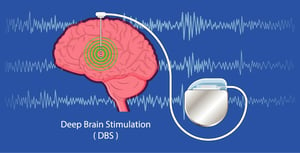The most severe forms of depression, which are resistant to pharmacological and psychotherapeutic treatments, as well as to tools such as electroconvulsive therapy (the modern version of electric shock therapy) could be cured, in the future, with deep brain stimulation or DBS, a technique already used to mitigate the effects of Parkinson’s disease. What is DBS? In DBS, the neurosurgeon inserts tiny electrodes into the brain, connected to a small external device, which then stimulate several areas of the brain involved in the “management” of the symptoms of depression (by sending very weak electrical impulses). This therapy was suggested in the American Journal of Psychiatry by neurologists from the Mount Sinai Hospital of New York, who describe what happened to 28 patients, operated on at different times and then followed for a period of four to eight years.
The electrodes were implanted into an area of the brain known as the subcallosal cingulate and, in particular, into the so-called Brodmann 25 Area. An initial study on several patients, started in 2005, was interrupted due to a lack of statistically significant data, but the researchers continued until they reached the number of 28 patients. They regularly checked what happened to these patients, trying to achieve results that could be evaluated using statistical methods. The numbers they found were reassuring: on average 50% of the depressed patients had had a response, 30% had gone into remission, 21% had shown a continuous response in the first year, and 75% a response for at least half of the length of the observation period.
In treating these forms of major depression, as well as bipolar disorder (which some of the patients suffered from), the duration of the response is fundamental, because episodes are recurrent and the most important thing is to prevent relapse.
Currently 23 out of the 28 patients are still being treated and are under observation. In the meantime, others are being recruited who will receive a state-of-the-art implant system. They will then be followed more comprehensively, i.e. also with imaging (MRI and others), laboratory and physiological examinations, and will undergo behavioral and psychiatric assessments. The aim is to better understand the potential of this approach and to identify the subgroups of depressed patients that could best benefit from deep brain stimulation.

